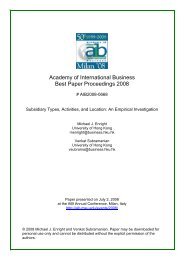AIB 2012 Conference Proceedings - Academy of International ...
AIB 2012 Conference Proceedings - Academy of International ...
AIB 2012 Conference Proceedings - Academy of International ...
You also want an ePaper? Increase the reach of your titles
YUMPU automatically turns print PDFs into web optimized ePapers that Google loves.
MONDAY<br />
with'. (For more information, please contact: Lin Yan, Anglia Ruskin University, United Kingdom:<br />
lin.yan@anglia.ac.uk)<br />
Resource Differences between Born Global and Born Regional Firms: Evidence from Canadian Small and<br />
Medium-Sized Manufacturers 1997-2004<br />
Sui Sui, Ryerson University<br />
Zhihao Yu, Carleton University<br />
Matthias Baum, University <strong>of</strong> Giessen<br />
While <strong>International</strong> Entrepreneurship research has intensively observed the creation and management <strong>of</strong><br />
<strong>International</strong> New Ventures (INV), we only have a limited understanding on different types <strong>of</strong> INVs. More<br />
specifically, we do not know why some INVs pursue geographically restrained internationalization (so called<br />
Born Regional Firms), while others decide for a globally dispersed approach (so called Born Global firms). This<br />
study draws on resource-based theory and applies logistic regression on a longitudinal sample <strong>of</strong> 604 Canadian<br />
exporting manufactures to investigate how firm internal resources differentiate between Born Global and Born<br />
Regional firms. We find that, compared to Born Regionals, Born Globals have significantly greater global market<br />
knowledge, and have significantly higher initial performance. (For more information, please contact: Sui Sui,<br />
Ryerson University, Canada: sui.sui.66@gmail.com)<br />
Models <strong>of</strong> <strong>International</strong> Entrepreneurship<br />
Morten Rask, Aarhus University<br />
Per Servais, University <strong>of</strong> Southern Denmark<br />
The aim <strong>of</strong> this article is to provide a comprehensive review <strong>of</strong> models used to depict infant firms that operate<br />
internationally right from or close to inception, so-called international new ventures (INVs) or born global firms<br />
that emerged in the literature in the early 1990s up until today. The purpose with this article is to give a<br />
comprehensive overview <strong>of</strong> models used to describe and explain the establishment and development <strong>of</strong><br />
international new ventures. Based upon a diverse platform <strong>of</strong> types <strong>of</strong> research and types <strong>of</strong> models we have<br />
developed three meta-models <strong>of</strong> international entrepreneurship. The matrix model defines types <strong>of</strong> international<br />
entrepreneurial firms. The multi-stimuli model explains how the external environment factors and the internal<br />
organizational and managerial factors influence the international entrepreneurship strategies. The stimuliresponse<br />
model explains the antecedents/drivers <strong>of</strong> moderators in and performance by international<br />
entrepreneurship. These models reflect the merger <strong>of</strong> entrepreneurship and international business into the field<br />
<strong>of</strong> international entrepreneurship. Managers in international entrepreneurial firms and students in international<br />
business and entrepreneurship can use the models as framework for understanding international<br />
entrepreneurship. A call for more research on cross-country comparative aspects together with more focus on<br />
products and business opportunities in relation to international entrepreneurship finalize the paper. (For more<br />
information, please contact: Morten Rask, Aarhus University, Denmark: mr@morten-rask.dk)<br />
Born Globals: Evolution and revolution as organisations grow<br />
Vítor Corado Simões, ISEG, Technical University <strong>of</strong> Lisbon<br />
Jacinto Antunes Celorico, ISEG, Technical University <strong>of</strong> Lisbon<br />
Luís Filipe Laranjeira, ISEG, Technical University <strong>of</strong> Lisbon<br />
This paper is intended to assess the relevance <strong>of</strong> the punctuated equilibrium model (Gould, 2002; Romanelli<br />
and Tushman, 1994) and Greiner's (1972) "evolution and revolution" models to explain how Born Global firms'<br />
(BGs) behaviors and structures change as they get older. Three main perspectives (Business model,<br />
Configuration <strong>of</strong> assets and responsibilities, and Top management logic) were used to enable the identification<br />
<strong>of</strong> "evolution and revolution" phases in two exploratory cases. The paper shows that BGs follow different<br />
stages, corresponding to new combinations <strong>of</strong> business models, configurations <strong>of</strong> assets and responsibilities,<br />
and top management logic. Changes are a result <strong>of</strong> internal perceptions, capabilities and tensions, and external<br />
<strong>AIB</strong> <strong>2012</strong> <strong>Conference</strong> <strong>Proceedings</strong><br />
Page 175

















